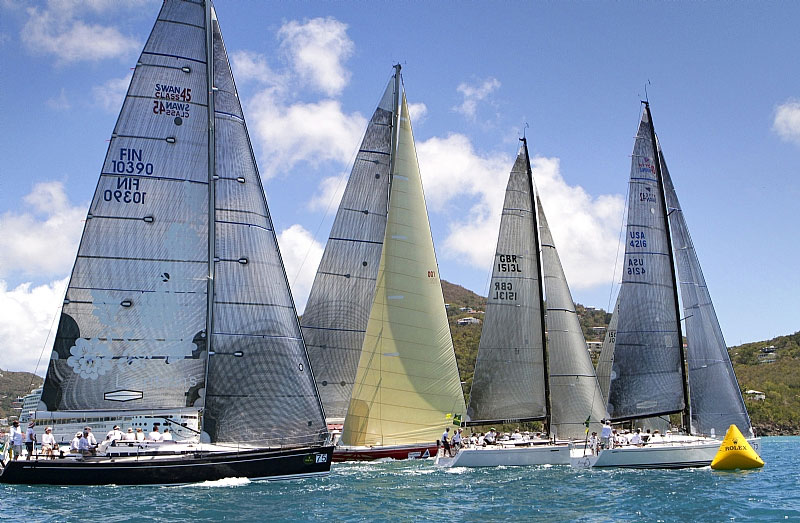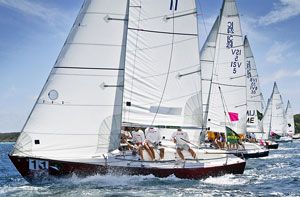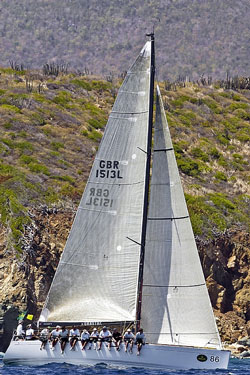
110331_Race2_Start
Forrest Gump’s catch phrase about life being a box of chocolates is more than a bit overplayed at this stage. But there really isn’t a better way to describe the appeal of random-leg racing, which has always been a staple of the International Rolex Regatta, hosted each year in late March out of the St. Thomas YC in the U.S. Virgin Islands. I was working on an intro comparing random-leg racing to the 1970s phenomenon of Key Parties, but while it sounded so witty while basking in the glow of a spectacular Caribbean sunset (and of a few rum punches) it didn’t quite have the same allure when I returned to the office and started to compile this piece. So I figured I’d leave that one on the bench and go with old reliable.
In our unfettered desire to produce courses and classes that most consistently reward the “best” sailors, random-leg racing has taken a hit. Many sailors view a leg that isn’t dead upwind or dead downwind as something other than a pure test of skill. A few years ago, in the interest of streamlining the management of a late-season portion of a summer one-design series in Newport, I suggested we fix the start at the harbor mouth and run random leg races as opposed to the normal windward-leeward courses. I was quickly shot down. “If you want that,” they said, with a sneer, “go sail with the local PHRF fleet.”
I think the sport should revisit random-leg races. They make the most sense for handicap racing, but even for one-design competition, random legs force everyone to view something with which they have become very familiar—racing a sailboat—in a new, usually invigorating, light. Occasionally, they also provide a lesson or two that just isn’t available when sailing the normal sausage-shaped course.
It all starts with the mystery, just like the proverbial box of chocolates. Instead of worrying about whether the piece you chose is full of that toxic cherry liquor, or the mushy peanut paste, sailors must obsess over the true wind angle for each leg, the best sail combination for each point of sail, the fastest route to the next mark, or, in the case of handicap racing, whether their boat will be faster or slower than the key competition, and how to take advantage of that differential.
The evening before the first day of racing at the Rolex Regatta—where I sailed with Phil Lotz’ Swan 42 Arethusa—I hunkered down with the boat’s resident sailmaker, Lotz, and a few others. We spent an hour or more pouring over the sail chart, the forecast for the following day, and the potential courses. We talked about sail limits, staysails, and outboard leads. We debated the merits of the A3 spinnaker versus the A0 and the upper range of the A1.5. My wife, who is a casual racer, watched with mild amusement. When I told her later that our final decision was to table the conversation until the morning when we would have a more reliable forecast, her jaw dropped slightly. She didn’t say it, but I knew what she was thinking: “All that and you didn’t even make a single decision? What a bunch of geeks.”
And she’s probably right. But sailing is at least 50-percent mental. Anyone passionate about the sport is at least partly attracted to the mental game. For proof of this you need attend just one post-regatta party to see what percentage of the attendees are still talking about the racing hours after the last gun. Talking about sailing is, for most sailors, almost as fun as actually doing it. For the rest, it’s more fun.
Once the racing started, the random courses meant we were constantly discussing about what was coming next. How much of a wind shift would allow us to pop a spinnaker on this reach? Would we need the genoa staysail on this leg? Is the next rounding to starboard or to port? How should we take down the sail to best set it up for the next leg? It went on and on. The start of the second race was particularly interesting as boats could lay the first mark from the port-half of the line. We just snuck around it and we able to extend away in clear air. But it was close to being a complete disaster.
The big knock on fetches—legs that don’t require a tack or a jibe—or even legs that are heavily biased toward one tack or jibe, is that they tend to be parades. And this can be true. There are fewer passing lanes when boats don’t have to switch tacks. However, anyone who dismisses a 1-mile tight reach as a leg where nothing can change is likely losing ground. In handicap racing, boats must push all the way around the track to save their time. Even in one-design sailing, while getting around a boat directly in front of you may be difficult, closing to within striking distance for the next beat or run is very achievable, especially if the guy in front is coasting a bit and you know exactly how to set up the outboard lead for your headsail for maximum speed. And in classes with a limited sail inventory, passing lanes will occasionally open up because the fastest path between two marks may not be a straight line. In the case of a 110-degree true wind angle reach, the answer could be to sail high of the rhumb line until it’s possible to set the spinnaker.
Finally, there’s the value of getting to know your boat a little better. Even if your primary goal is to win a regatta featuring exclusively windward-leeward courses, you never know when you’ll find yourself pushed over the layline and needing to reach off to make the mark, or when the wind will go haywire and a run to the finish will turn into a tight spinnaker reach. The ability to quickly shift the set-up of your boat to maximize boatspeed on an off-angle leg, or for the bow team to quickly move the gear around for a starboard–side hoist, could make a difference in the final results.
I’m not advocating a wholesale change to random-leg racing. I like my windward-leewards as much as most one-design sailors. In other words, more often than not, I prefer the monochromatic bar of Toblerone—with the ingredients right on the box—to the secrecy of the Whitman Sampler. However, occasionally, I enjoy pondering for a few minutes a box of 36 little pieces of chocolate, making a choice based on little more than guesswork, and seeing what I come up with.

Ingrid Abery/St. Thomas YC/Rolex| |**The 16-boat IC 24 fleet enjoyed great one-design racing at the IRR, with 17 races over 3 days. **|
Other Notes from St. Thomas:
• The I**C 24 fleet **is going strong in the Islands. In case you don’t know what an IC 24 is, it’s a J/24 hull and rig retro-fitted with a legs-in, day-racing cockpit on top and using only the 100-percent jib. Sixteen boats competed at the Rolex Regatta and sailed 17 races (in just three days, phew). We sailed past as they rounded a windward mark and all 16 boats were stacked up nose to tail. I could think of many worse vacations than chartering an IC 24 for the Rolex Regatta, chartering a 40-foot mothership for housing, and anchoring in Christmas Cove, just cross the channel from the St. Thomas YC.
• Three TP/IRC 52s raced in IRC 1 and it seemed like they enjoyed some close competition. Jim Swartz’ Vesper (formerly Quantum Racing’s MedCup boat) was the class of the fleet, winning 5 of six races. Here’s hoping the owners of these 52 footers, and the others like them in the United States, can get together and develop something of a circuit. There are enough of these boats to create some great racing provided the owners can agree on which regattas to attend. It would have to be under IRC, given how many of the boats have been taken out of TP 52 trim, or never built to it to begin with. But with a relatively small rating box—the three boats in St. Thomas were separated by .006 on their IRC rankings—and some basic length, weight, and sail area requirements, the racing would be virtually one-design and very competitive.

Ingrid Abery/St. Thomas YC/Rolex| |The Grand Soleil 43 appears to be the latest in a long line of strong handicap boats produced by the Italian Cantiere del Pardo yard.|
• A decade ago, the Grand Soleil 42 was the boat to beat on the European IMS circuit. If the performance of Willem Wester’s Grand Soleil 43 Antilope at the IRR is any indication, the company has found another handicap winner. The boat won every race in IRC 2, four of six by more than 3 minutes on corrected time over the second-place boat. Wester stacked his boat with some serious talent, led by tactician Bouwe Bekking, and they sailed exceptionally well. They never seemed to get caught downspeed and didn’t make any discernable sail handling mistakes. But the boat also appears to have found a sweet spot in the rule in 12 to 18 knots. Lotz has worked hard to optimize IRC rating of Arethusa, yet we owed Antilope—which is a foot longer—nearly 3m:15s for every hour of racing. And we regularly struggled to beat it over the line.
• The first race of the International Rolex Regatta featured a downwind start. I don’t think I’d done one since the last time I sailed the IRR in 2008. Just like with the random-leg courses, a downwind start forces you to look at something you’ve done 1,000 times in a totally new light. It was a lot of fun. And it could be even better in a one-design fleet, though sprit boats in heavy air, starting downwind might be a recipe for disaster. The ensuing leg would need to be long enough to sort out the pecking order a bit before the first mark—and a gate would be a good idea as well, to spread out a packed fleet—but the racing to the first mark would be intense, especially in boats with symmetrically-rigged spinnakers, where the horizontal separation in moderate and heavy air is minimal.









